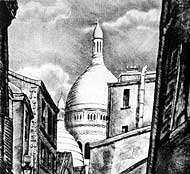|
When he was not at school studying Art, André was visiting Paris with both eagerness and enthusiasm. He actually kept this enthusiasm his entire life. He visited all the museums to learn more about the masterpieces of past and present. One day, Rue de Seine, he remained captivated before a pencil sketch, "le Repas Frugal", signed by Pablo Picasso.
He rapidly made a network of friends and acquaintances. In 1925, he underwent military service at Fort de Domont outside Paris together with Louis-Joseph Soulas and Edouard Mac-Avoy. 4 years later, with a few other up-and-coming artists including Yves Alix, Amédée de la Patellière and Jacques Villon, André Jacquemin founded "la jeune Gravure Contemporaine", a society of Printmakers.
|
 |
 Biography I
Biography I  Jaclet
Jaclet Biography I
Biography I  Jaclet
Jaclet